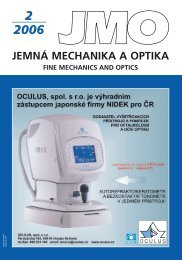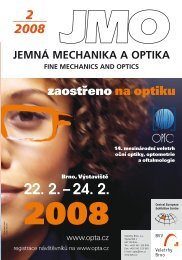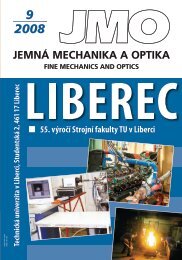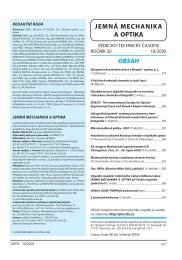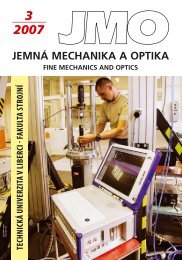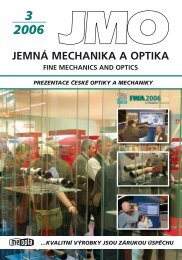5 2006 jemn mechanika a optika fine mechanics and optics - Jemná ...
5 2006 jemn mechanika a optika fine mechanics and optics - Jemná ...
5 2006 jemn mechanika a optika fine mechanics and optics - Jemná ...
You also want an ePaper? Increase the reach of your titles
YUMPU automatically turns print PDFs into web optimized ePapers that Google loves.
• The total of needed tools has to be two to three times higher<br />
than a weeks supply because of job coaters. Therefore In-house<br />
coating can reduce storage costs significantly.<br />
7. Are there damages or mix-ups at packing <strong>and</strong> unpacking to<br />
<strong>and</strong> from the job coater?<br />
• There is a risk for these problems to occur. With in-house coating<br />
these activities are unnecessary.<br />
• Experience shows that personnel costs of in-house coating don’t<br />
exceed costs those for logistics of job coaters.<br />
8. Does the company have problems with cobalt-leaching at<br />
recoated tools?<br />
• With in-house coating, the optimal production cycle for reground<br />
tools can be maintained: Decoat – Regrind – Recoat. Therefore<br />
the danger of cobalt-leaching by decoating is being eliminated.<br />
• Usually at job coating, regrinding precedes decoating <strong>and</strong> recoating.<br />
9. Do SMEs want to determine the pretreatment for active<br />
surfaces <strong>and</strong> cutting edges on their own?<br />
• Since job coaters can’t know the surface consistency of various<br />
objects, usually they micro-blast all tools to avoid bad coating<br />
adhesion. This can negatively affect the functional efficiency of<br />
finishing precision tools, which need sharp cutting edges.<br />
• The performance of tools often depends on the special configuration<br />
of cutting edges, die geometries or contact surfaces, <strong>and</strong><br />
the like. Of course, SMEs don’t like to give away their small<br />
<strong>and</strong> big secrets. But their competitors often make audits at the<br />
job coaters.<br />
• At in-house coating, the SMEs can take care of their own tools<br />
<strong>and</strong> surely about their optimal pretreatment to 100%.<br />
10. Do SMEs want to have full control over their production<br />
<strong>and</strong> earn money through expansion to a new technology?<br />
• In spite of massive price reductions, job coaters still have good<br />
profits.<br />
Fig. 7 Flexible usage of LARC ® compact-systems with rotating<br />
cathodes for coating special substrates with highest requirements<br />
<strong>and</strong> performance<br />
������<br />
• Through increased competition, job coaters lower prices. There<br />
are job coaters who openly say that they only offer basic coatings,<br />
but for a minimal price. This means competition for mass-coaters,<br />
but not for SMEs who have to achieve outst<strong>and</strong>ing tool performance.<br />
(Fig. 7).<br />
• Because of the disadvantages of job coating, SMEs often send<br />
the parts for coating only when coating is absolutely necessary.<br />
For that they don’t make much money. In-house coating automatically<br />
generates self-profit, new parts to coat <strong>and</strong> therefore<br />
business volume (Fig. 1).<br />
Summary<br />
“All leading tool producers can h<strong>and</strong>le cutting material <strong>and</strong> geometry.<br />
The ones, who use the best coating technologies, will have<br />
the biggest shares on the high-tech market“[2]. That’s why the way<br />
of mass-coating can’t be the way to future for high-tech SMEs.<br />
If the future oriented SME-owner or -CEO answers most of<br />
these questions with “yes”, then he will integrate coating his own<br />
production. Therefore he will:<br />
• Minimize delivery-times of his total product-lines,<br />
• Generate new coatings (like nanocomposites) <strong>and</strong> coating<br />
br<strong>and</strong>s,<br />
• Reduce logistics-, transport <strong>and</strong> storage costs,<br />
• Operate with own pretreatments, tool geometries <strong>and</strong> keep them<br />
for himself,<br />
• Manage the quality <strong>and</strong> time for the entire production-process<br />
on his own <strong>and</strong><br />
• Make money through coating.<br />
References<br />
Dr. Tibor Cselle, PLATIT AG, Moosstrasse 68, 2540 Grenchen, Switzerl<strong>and</strong><br />
[1] Morstein, M., a. o..: New LARC ® -Coatings for St<strong>and</strong>ard <strong>and</strong><br />
High-Performance Applications SWISSMEM-Seminar, Winthertur,<br />
Switzerl<strong>and</strong>, Jan/2005<br />
[2] Müller, M. (Walter AG-S<strong>and</strong>vik): High Performance Cutting<br />
with Carbide Tools Conference for Tooling, Schmalkalden,<br />
Germany, Nov/2004<br />
[3] Patscheider, J.: Nanocomposite Hard Coatings, MRS Bulletin<br />
28/3, 180 (2003)<br />
[4] Suzuki, T., a. o.: Microstructure <strong>and</strong> Secural Instability of<br />
(Ti1-xAlx) N-Films Journal of Materials Science 35 (2000)<br />
p. 4193-4199<br />
[5] Veprek, S. a. o.: Avoiding the High-Temperature Decomposition<br />
<strong>and</strong> Softening of (AlTi)N Coatings Materials Science <strong>and</strong><br />
Engineering A 366 (2004) p. 202-205<br />
[6] Cselle, T.: Driving Forces of Today’s Manufacturing Technology<br />
Industrial Tooling, Southampton, UK, Sept/2003<br />
[7] Cselle, T., a. o.: Application of Coatings for Tooling – Quo<br />
Vadis 2005? VIP Vacuum’s Best, Wiley Publication, Weinheim,<br />
Germany, 2005<br />
���



